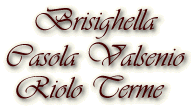Civic Tower (16th C.)
In the town centre. The Clock was added in 1560 so that the townspeople would not have to live "dependent on nature".
Archpriestly Church of Our Lady of the Assumption (16th C.)
In Via S. Martina. It contains precious stuccowork.
Medical Garden
Almost permanent exhibition of aromatic, medicinal, essence-bearing and cosmetic plants. As well as attracting 20.000 tourists a year, it is used for experiments and teaching and boasts a very well stocked scientific library.
The Cardello
A noble building where the writer Alfredo Oriani spent almost all his life. Originally it served as guest-quarters for the 10th century Abbey of Valsenio but the building today, extensively re-done in 1926, is only partly faithful to the original. The interior still bears the stamp, given it by Oriani, of a Romagnol gentleman's home. The grounds are especially beautiful.
Abbey of Valsenio (10th C.)
A Benedictine complex of special architectural value and particular historical interest.
The Chalk Vein
This is a chalk-sulphureous geological formation which is interesting for several reasons and is a protected Regional Park area. Over and above its speleological interest there are attractive botanical and zoological itineraries.
King Tiberius' Grotto
The Chalk Vein shows karst phenomena with grottoes, dolinas and swallow holes. Of special interest is King Tiberius' Grotto (306 metres deep) where human traces dating back to prehistory have been found.
The Ceruno Tower (14th C.)
This massive tower belonged to the Ceronesi, a grouping of families that dominated the Senio Valley until the 16th century.
Pinewood Hill
A woody height dominating the town and the valley, rich in pleasant pathways.
Battle Hill
At the watershed between the Senio and Santerno valleys there is a 12th century mediaeval fortress which has recently been restored. Opposite it there is a bronze monument commemorating the battle fought here during the 2nd World War.
The "Di Sopra" Church (13th C.)
The ruins of its walls and the bell-gable tower overlook the town.
Oriano (13th C.)
A fortified nucleus, once the home of the Oriani family.
Sant'Apollinare (14th C.)
Contains a painting on wood by the painter Innocenzo of Imola.
"Sun Garden" Swimming Pool
Heated by solar panels.





